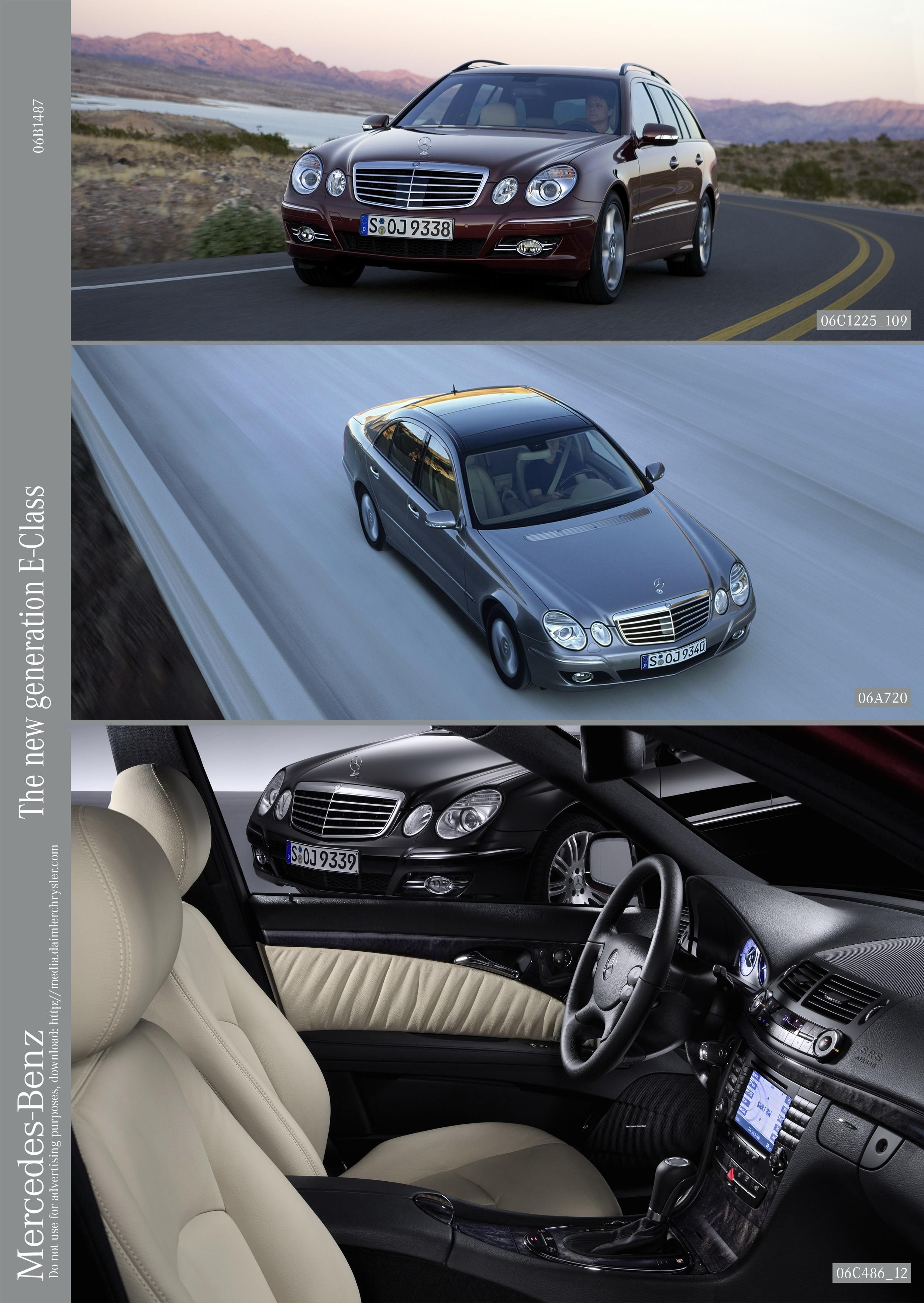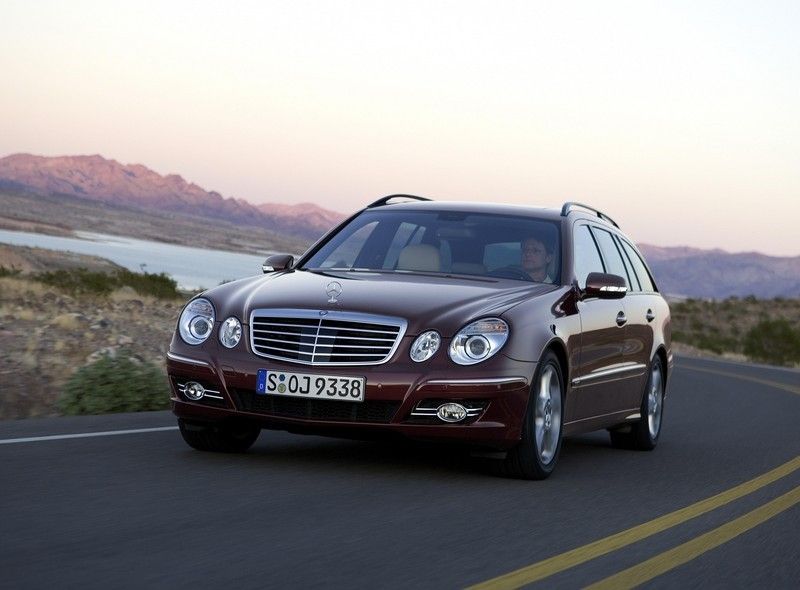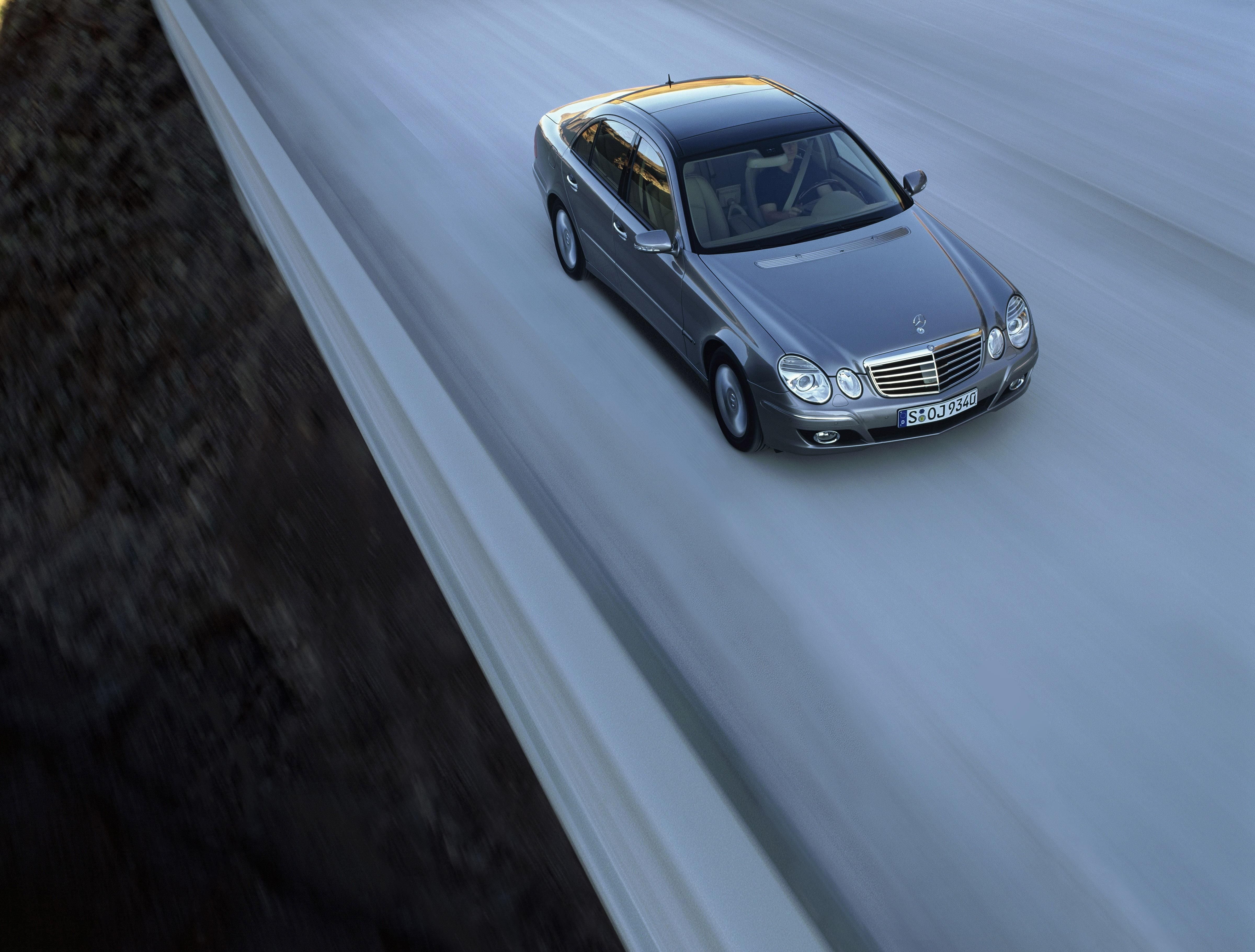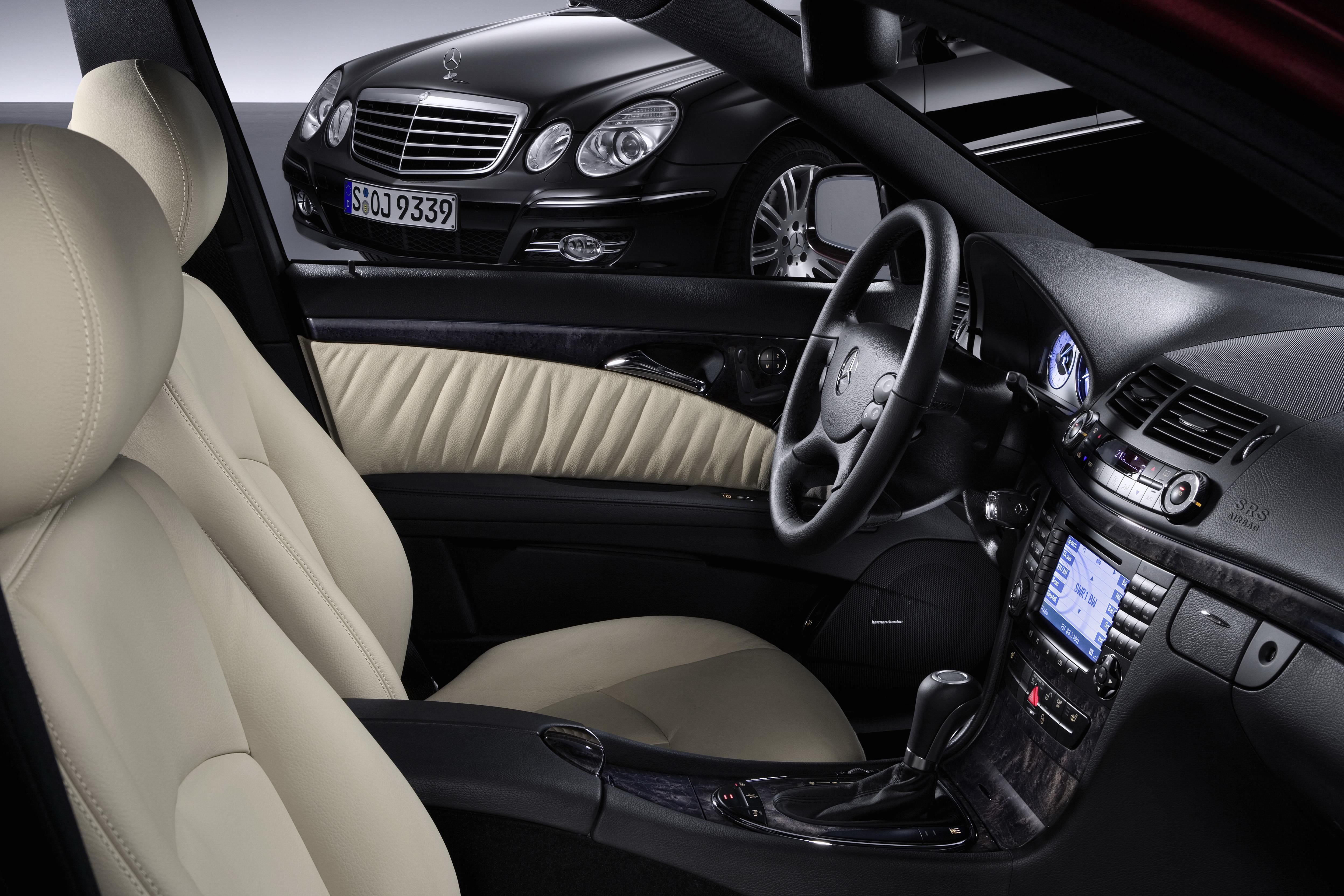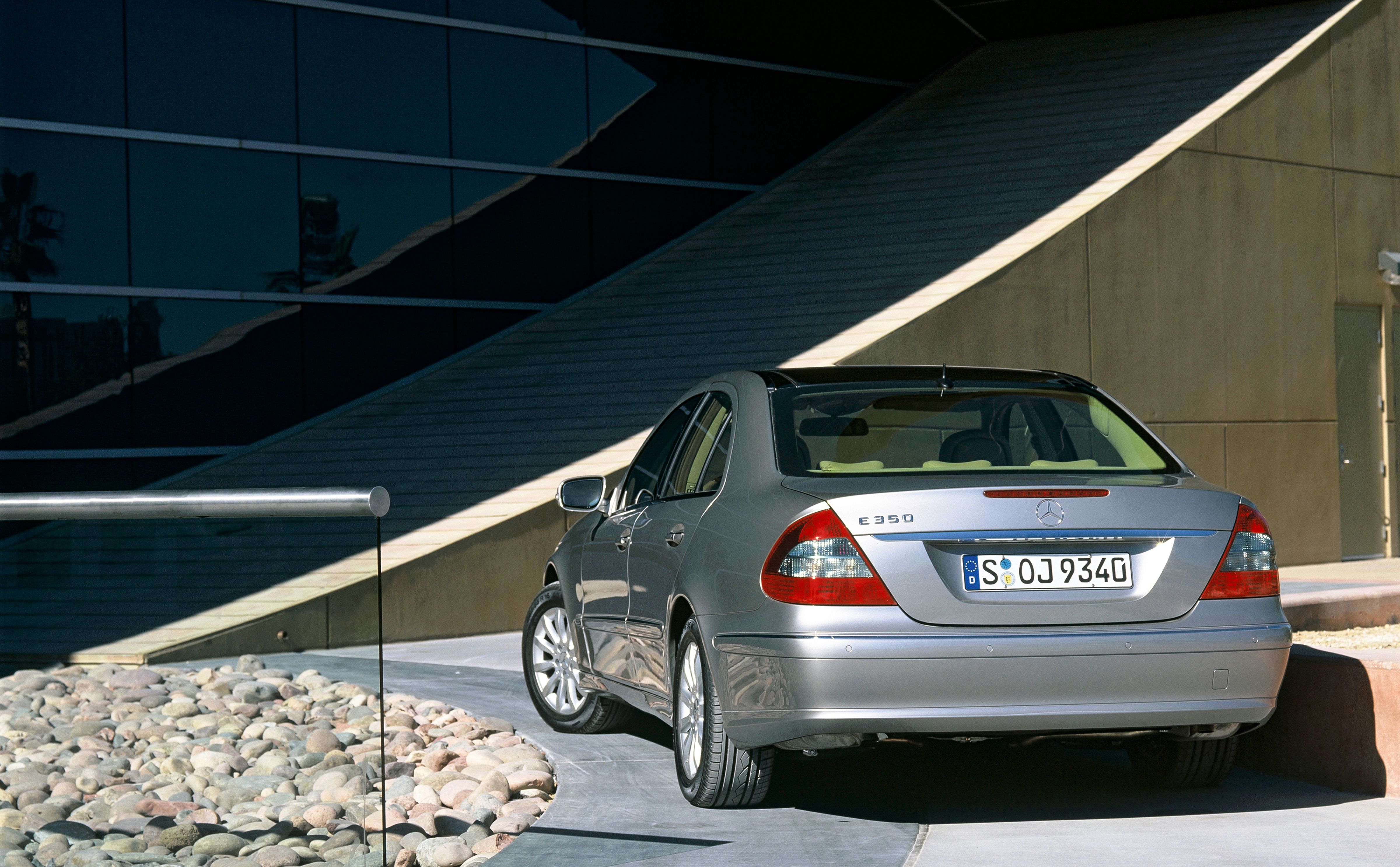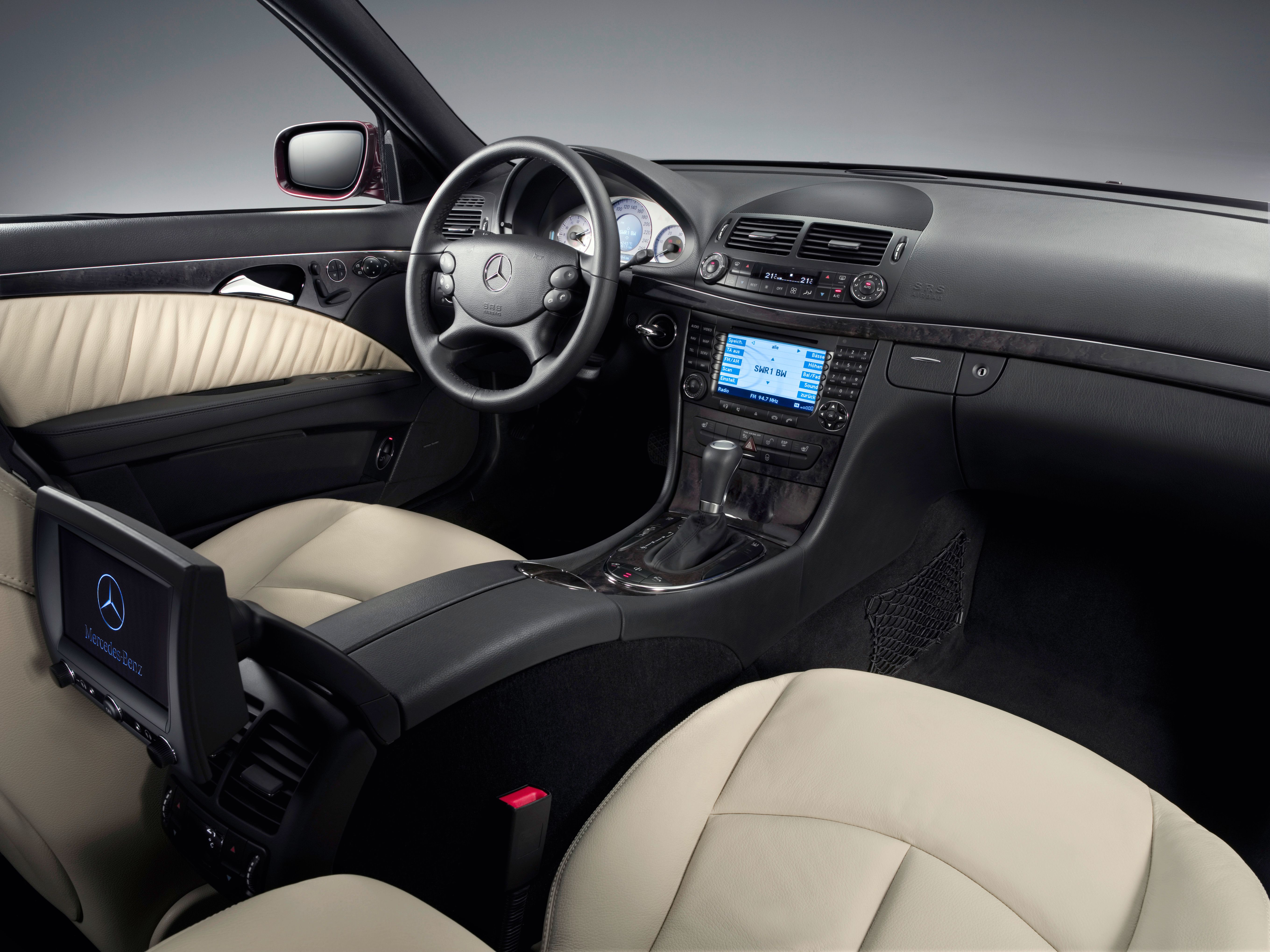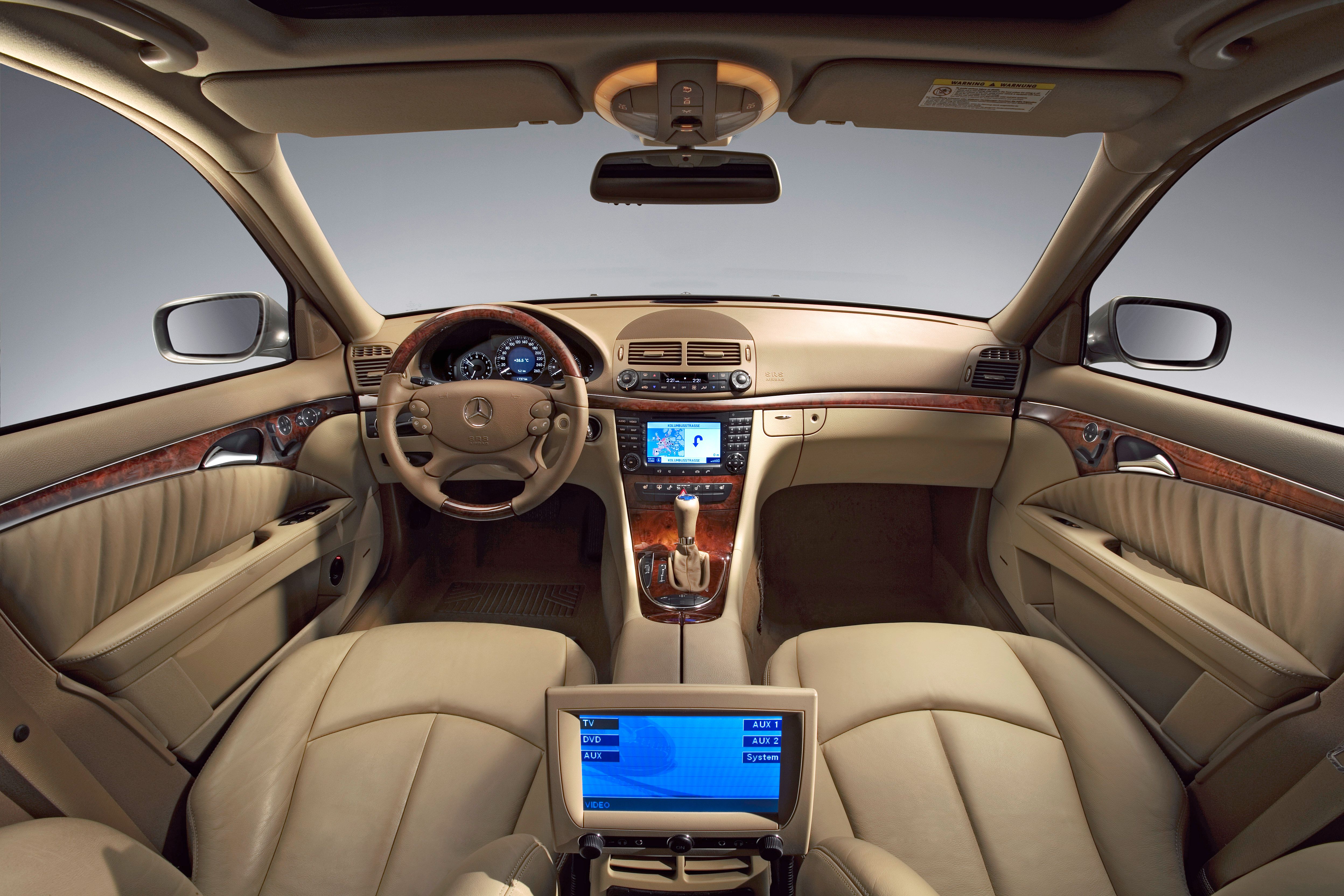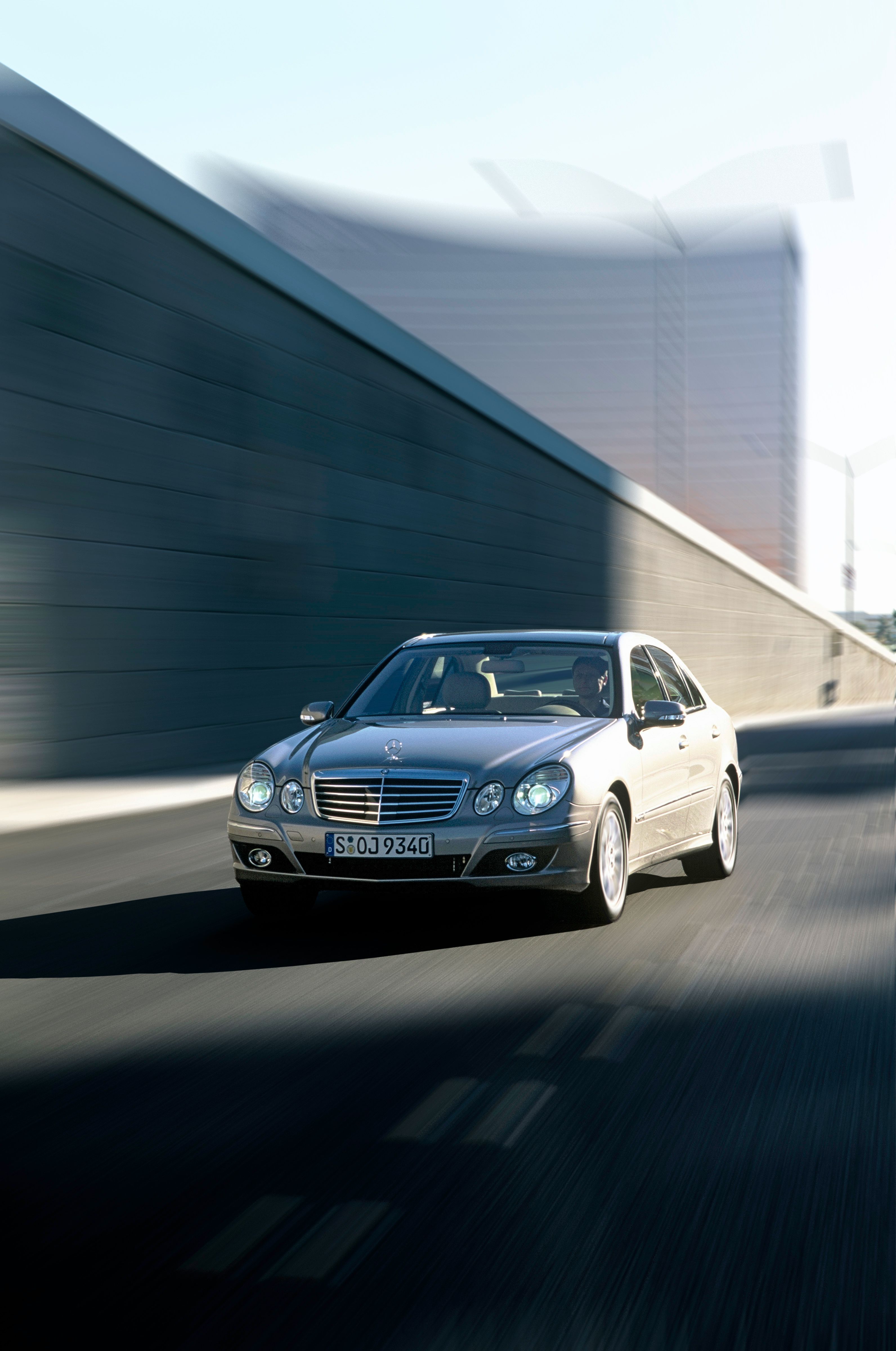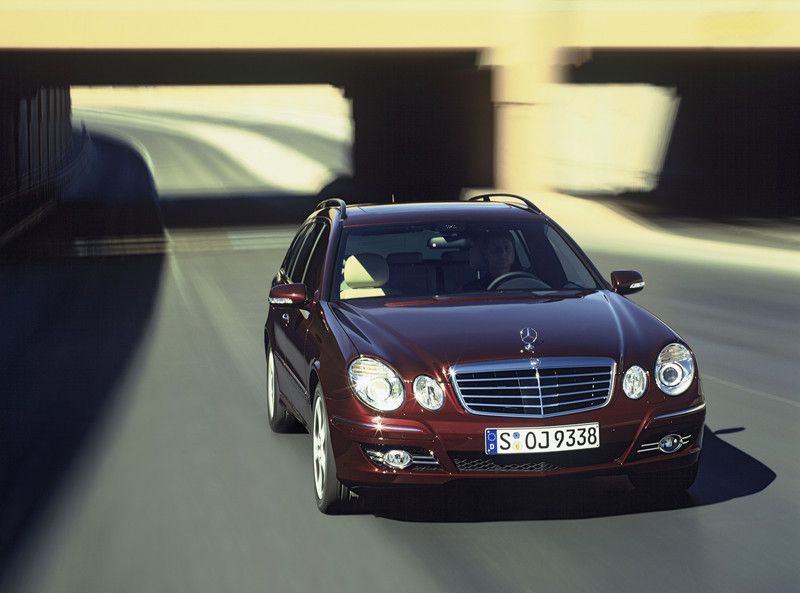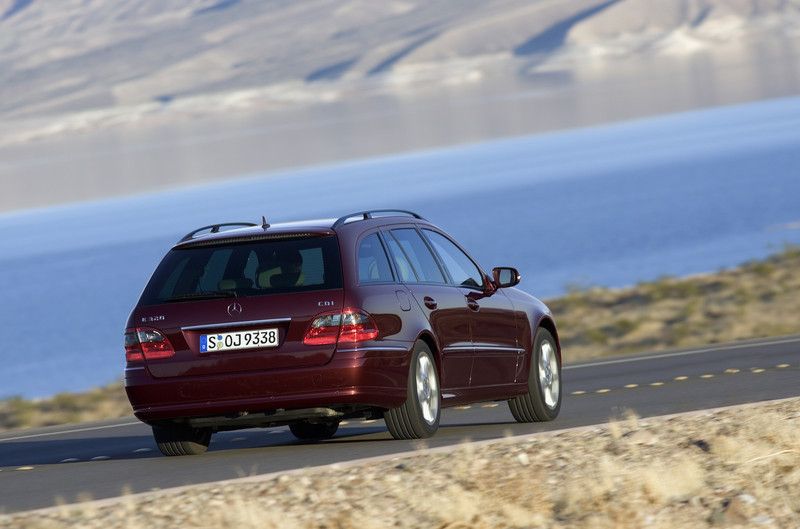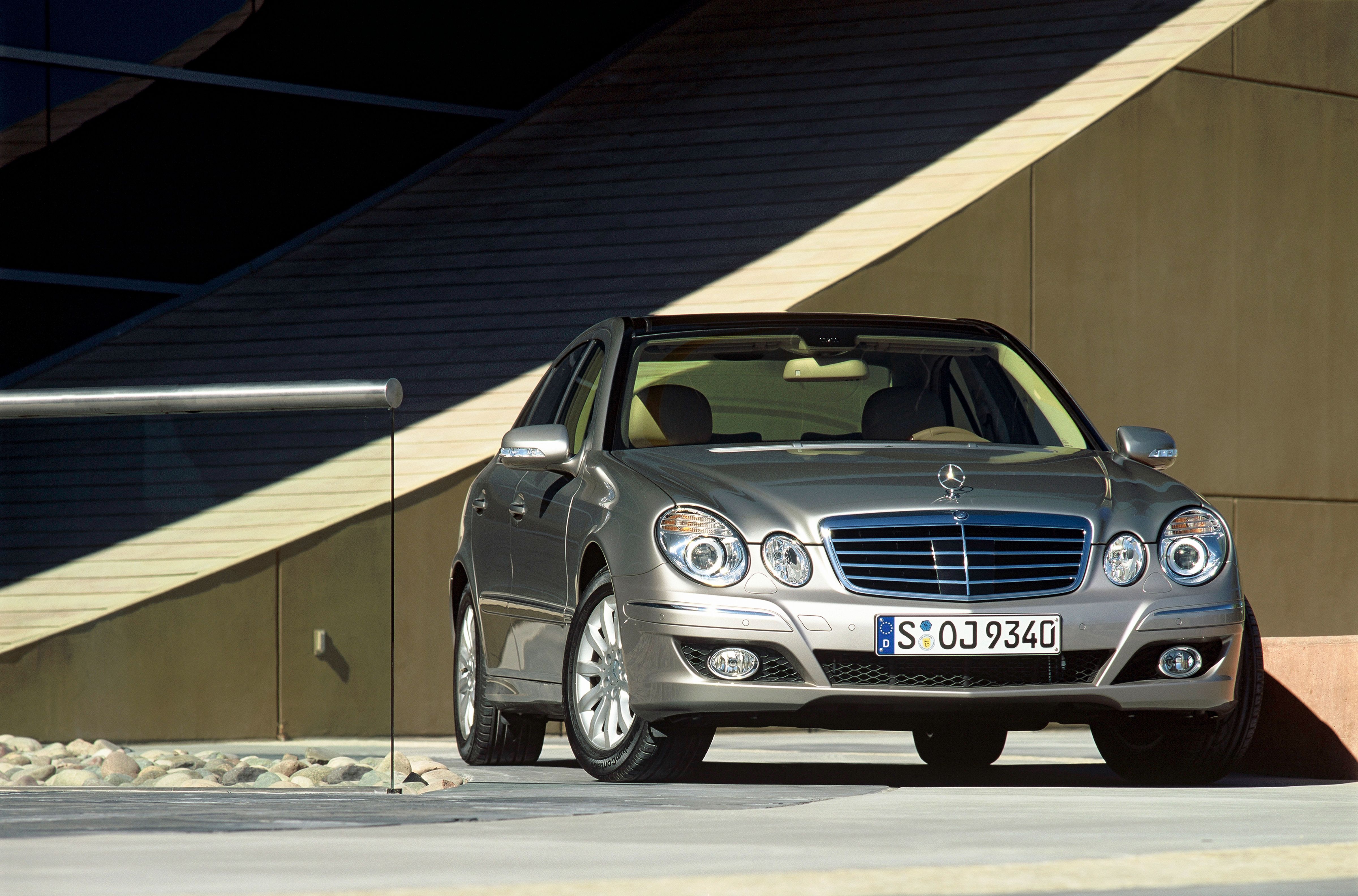After four years in production and around a million vehicles sold, Mercedes-Benz is presenting the new generation of its world-beating E-Class. Some 2000 parts in the E-Class are new or further developments. The Saloon and Estate boast new bodystyling, which is even more dynamic, poised and assured than before. The E-Class is once again setting the benchmark as the technology trendsetter. No other car in this market segment can match the range of safety innovations including PRE-SAFE®, Intelligent Light System, NECK-PRO head restraints and adaptive brake lights. These extensive safety features make the E-Class the safest car in its class.
2007 Mercedes E-Class
- Make: Array
- Model: 2007 Mercedes E-Class
The DIRECT CONTROL package, with more direct steering and a retuned suspension, and six new or enhanced engines take agility and driving pleasure to new heights. Maintaining the same level of fuel economy, these engines develop up to 26 percent more output and 18 percent more torque. The prices for the four and six-cylinder models remain unchanged despite the more extensive standard specification.
The E-Class was the No. 1 archetypal executive saloon in Western Europe in 2005, accounting for 30 percent of the market. In Germany 38 percent of all buyers of premium models chose the E-Class Saloon, helping maintain the Saloon's position as German market leader for four years running. Worldwide Mercedes-Benz has sold around a million vehicles from the current E-Class line-up since spring 2002 - 860,000 Saloons and 140,000 Estates.
For over 60 years the E-Class and its predecessors have been the “heart” of Mercedes-Benz, representing basic brand values like safety, comfort, innovation, economy and quality. Since 1946 Mercedes-Benz has delivered some ten million luxury sedans to customers all over the world.
In June 2006 the E-Class will be unveiled with an even more dynamic concept, additional pioneering innovations and an upgraded standard specification.
29 model variants will be available - 16 Saloons and 13 Estates. As such, Mercedes-Benz will be offering the largest, most varied model range in this market segment. With outputs ranging from 100 kW/136 hp to 378 kW/ 514 hp, the new generation E-Class outpaces the previous model range (90 kW/122 hp to 350 kW/476 hp) and its competitors.
A revamped front-end design reflects the dynamism, power, poise and assurance of the new generation E-Class. The bumper and radiator grille feature a pronounced V-shape, which epitomises power and forward motion. Mercedes Benz has enhanced the familiar twin-headlamp face of the E-Class by adding transparent louvres to the top section of the headlamps, producing a striking light effect when switched on. And for the first time white LEDs have been used as parking lights. Mercedes-Benz has further accentuated the dynamic appearance of the E Class on all model variants with side skirts and rear bumper in the AVANTGARDE design.
Inside, the new generation model differs from the outgoing model with new eye-catching colours, a new four-spoke steering wheel featuring elliptical thumb-operated buttons and a new control unit for the standard-fit THERMATIC automatic climate control. The Mercedes designers have also redefined the coordinated colour schemes, upholstery and materials; for the AVANTGARDE line in particular there are two new colours (cognac brown and sahara beige), which add an extra touch of refinement in conjunction with the black roof lining.
E-Class: Safest vehicle in its class
Thanks to its pioneering innovations, the E-Class continues to be the safest vehicle in its segment. “One of the key features of the new-generation E-Class is its outstanding safety level,” says Maier. “It is clearly the safest vehicle in the upper-range segment.”
Standard equipment in the sedan and the station wagon models will now include the anticipatory PRE-SAFE® system, which automatically activates safety measures for the driver and front passenger if an accident becomes imminent. The award-winning system makes the most effective use of the seatbelt and airbag in the event of a collision. No other upper-range car in the world offers a comparable safety system. Also unique are the standard NECK-PRO headrests, which provide sensor-controlled head support for the driver and front passenger during rear-end collisions. Mercedes-Benz has also enhanced occupant safety by equipping the new-generation E-Class with blinking brake lights that activate to prevent rear-end collisions during emergency braking maneuvers.
-----
Intelligent Light System: World premiere of a new headlight system
The new-generation E-Class is the world's first automobile to be equipped with adaptive headlights that optimally adjust to driving and weather conditions, thus substantially improving driving safety. The new headlight technology - known as the Intelligent Light System - is available as an option for the sedan and station wagon and features five different light functions. The new country mode extends the motorist's field of vision, ensuring faster recognition of obstacles or other road users. The system's highway mode creates a uniform cone of light that automatically illuminates the width of the entire road at speeds of 90 km/h and higher. Compared to the previous version, the new system extends the driver's field of vision by about 50 meters in the center of the cone. An improved fog light system also makes it easer to drive in fog, and the active cornering light function has been enhanced as well. The Intelligent Light System also features a cornering light that improves safety at intersections and when taking curves at low speeds.
New diesel and gasoline engines: A big boost in power and agility
Six of the ten engines available for the new-generation E-Class are either new or have been enhanced. The four-cylinder-diesel engines for the E 200 CDI and E 220 CDI in particular have been optimized down to the last detail in order to further improve output, torque and smooth running characteristics.
Mercedes-Benz has been offering the E 320 CDI in the U.S. since 2004, making it the first diesel-powered car in the upper-range segment of the U.S. market. Beginning in autumn 2006, Mercedes-Benz will also be offering the first BLUETEC series-production vehicle in the U.S. The automobile is equipped with the cleanest diesel engine in the world, which considerably reduces nitrogen oxide emissions in particular. At the same time, the E 320 BLUETEC consumes 20 to 40 percent less fuel than comparable gasoline-powered vehicles. Mercedes-Benz is also preparing to launch the first BLUETEC-equipped passenger cars in Europe by 2008.
The gasoline engines for the E-Class were also enhanced, and the engineers at Mercedes focused particularly on the four- and eight-cylinder drive systems. At the top of the E-Class' engine range will be the all-new 5.5-liter V8 from the S Class, with an output of 388 hp. The model lineup will be expanded by the E 63 AMG, whose 514 hp engine makes it the most powerful E-Class ever built. Agility and driving pleasure will be greatly enhanced not only by the new and improved engines, but also by the DIRECT CONTROL package with more responsive steering and a retuned chassis.
The 60-year success story of the Mercedes-Benz E-Class: 10 million E-Class vehicles delivered to customers worldwide
For more than 60 years, Mercedes-Benz' upper-range model has epitomized the brand's signature attributes, including safety, comfort, innovation, fuel economy and quality. Since 1946, about ten million customers from all over the world have opted for Mercedes-Benz' upper-range model. And the seventh generation of this successful model, the current E Class, has also been a great success: One million sedans and station wagons have been sold worldwide since this model was launched on the market in 2002. As a result, more E-Class vehicles were sold during this time period than any other competing premium-class automobile. In 2005, the E-Class defended its leading market position in both its home market of Germany and in the rest of Western Europe, despite having to contend with substantially younger competitors in the premium segment.
Safety: setting the standards in the premium segment with PRE-SAFE® and other innovations
Pioneering innovations help the E-Class continue to set the pace of passenger car safety in its market segment: Saloon and Estate are equipped as standard with the anticipatory PRE-SAFE® system whose “reflexes” respond before an impending collision by activating protection measures for the driver and front passenger. As a result, the seatbelt and airbag provide maximum protection in the event of a collision. PRE-SAFE®, a world first which went into series production in the S-Class in 2002 and since then has received numerous international awards, heralds the start of a new era in vehicle safety. No other premium-class model can offer this kind of anticipatory protection system.
The standard-fit NECK-PRO head restraints on the E-Class are equally unique. During a rear impact the sensor-controlled head restraints are moved forward to provide protection for the driver's and front passenger's heads within milliseconds. The crash-responsive head restraints prevent the upper spinal column from bending as a result of the accident, reducing the risk of whiplash injuries, one of the most common accident injuries costing around eight billion euros annually in the European Union.
Mercedes-Benz is fitting the new generation E-Class with flashing brake lights to prevent rear-end collisions. They warn the drivers behind more effectively than conventional brake lights when there is a risk of an accident. Tests conducted by Mercedes engineers show that the drivers' braking reaction time can be shortened on average by up to 0.2 seconds if a flashing warning light is used during emergency braking. As a result, the braking distance can be reduced by 5.50 metres at 62 mph.
Mercedes-Benz has also consistently fine-tuned the occupant safety features on the E-Class. The Saloon and Estate meet the most stringent international crash standards such as the U.S. 80 km/h rear impact test or the new U.S. side crash test, which simulates a collision with a heavy off-road vehicle. To date, the E-Class has completed some 330 crash tests as part of ongoing improvements to vehicle safety.
-----
Intelligent Light System: world premiere of new headlamp technology
The new generation E-Class is the first vehicle to feature adaptive headlamps, which respond to the prevailing driving and weather conditions providing a significant improvement in driving safety. The Intelligent Light System, available as an option for the Saloon and Estate, is based on the powerful bi-xenon headlamps and includes five different lighting functions: the new country mode provides brighter, further illumination of the offside verge than the previous low-beam headlamps. Here the driver's range of vision is increased by around ten metres, which allows him to recognise other road users or obstacles earlier in the dark. The motorway mode, activated automatically at speeds above 90 km/h, produces an even light cone that extends to a range of up to 120 metres, illuminating the entire road width. In the centre of this light cone the driver can see around 50 metres further. Thanks to the enhanced fog lamps, also part of the new Intelligent Light System, Mercedes-Benz has also improved orientation in fog whilst reducing backglare.
The engineers in Sindelfingen have further developed and improved the Active Light System, which Mercedes-Benz unveiled in the E-Class in spring 2003. Another component of the Intelligent Light System is the cornering light function, which provides enhanced safety when turning at intersections or taking bends slowly.
Diesel engines: noticeably more output from the four-cylinder engines
Six of the 10 engines in the new generation E-Class are new or further developments. They provide up to 60 kW/82 hp more output and up to 70 Nm more torque. Nonetheless the fuel consumption figures remain on a par with the exemplary level of the outgoing models: one in three Mercedes models sporting an “E” on the model badge uses less than eight litres of fuel per 100 kilometres; the average fuel consumption of all body and drive variants in the line-up from the E 200 CDI to the E 500 is just nine litres per 100 kilometres. As such, the E Class will continue to build on one of its outstanding features: economy.
The Mercedes engineers have optimised the four-cylinder diesel engines in the E 200 CDI and E 220 CDI right down to the last detail. Over 90 components in the CDI engines are new or further developments. All these measures add up to a substantial advance in terms of output, torque and smoother running. While fuel consumption remains consistently low at just 6.3 litres per 100 kilometres, the output of the E 200 CDI has been increased by 10 kW/14 hp to 100 kW/136 hp. Maximum torque has been increased from 199 to 250 lbs-ft
Balancer shafts in the crankcase, standard specification also on the E 200 CDI, provide the sort of smooth-running characteristics more readily associated with a six-cylinder engine.
The new E 220 CDI develops a maximum output of 125 kW/170 hp and maximum torque of 400 Nm, around 14 and 18 percent respectively more than the outgoing model. Fuel consumption remains at the same low level of 6.3 litres per 100 kilometres (Estate: 7.1 l/100 km). Meanwhile the new six-cylinder diesel engine in the E 320 CDI (165 kW/ 224 hp) now provides even more torque: peak torque has been increased from 376 to 398 Nm.
In the USA the E-Class in the guise of the E 320 CDI since 2004 is the first diesel model in the premium-class segment in the USA. From model year 2007 Mercedes-Benz intends to launch the first diesel production vehicle in the USA with the trailblazing BLUETEC technology, which will provide further remarkable reductions in nitrogen oxide emissions. The future E 320 BLUETEC will be the world's cleanest diesel, using 20 to 40 percent less fuel than comparable petrol-engined vehicles. In Europe Mercedes-Benz plans to launch BLUETEC in a passenger car model by 2008.
Petrol engines: more powerful supercharged engine and new eight-cylinder engine
When it came to the petrol engines, the Mercedes engines paid particular attention to the four and eight-cylinder variants. The four-cylinder engine in the E 200 KOMPRESSOR delivers 12.5 percent more output than before: 135 kW/184 hp. At the same time, maximum torque has been increased to 250 Nm.
From mid-2006, the E-Class engine range will be headed by the newly developed 5.5-litre eight-cylinder engine from the S-Class with an output of 285 kW/388 hp. Compared with the previous V8, the new engine delivers 26 percent more output. At 530 Nm the torque also comfortably exceeds the maximum for the preceding engine by around 15 percent. The new E 500 delivers the performance profile of a sports car: the Saloon accelerates from 0 to 100 km/h in just 5.3 seconds, 0.7 seconds faster than the previous E 500.
The new E 63 AMG from the Mercedes-AMG stable is fitted with a naturally aspirated V8 engine delivering 378 kW/514 hp and maximum torque of 630 Nm. The E 63 AMG is the most powerful E-Class of all times.
DIRECT CONTROL: package for even more dynamic driving pleasure
The new generation of the successful Mercedes model series looks more dynamic, delivers more power and also offers even more agile handling. DIRECT CONTROL makes this possible: with this standard-fit package the Mercedes engineers have made remarkable progress in terms of handling dynamics, without compromising the combination of safety and long-distance comfort, the consistent hallmark of the E-Class Saloon and Estate.
Increasing the direct steering by around 10 percent makes the E Class more responsive to steering movements. Nonetheless the E-Class continues to reassure drivers with its superb handling safety and stability. Newly developed spring link bearings also support lateral forces more effectively when cornering and enhance the neutral cornering characteristics of the Saloon and Estate still more. The ELEGANCE and AVANTGARDE models also come with rebound buffer springs, which effectively limit body roll when cornering. The DIRECT CONTROL package also includes a new gearshift linkage system for the six-speed manual transmission for high gearshifting comfort and precision.
The ADAPTIVE BRAKE system is taken from the new Mercedes-Benz S-Class and provides new safety and comfort features thanks to the electronic control of the hydraulic dual-circuit brakes. An automatic tyre pressure loss warning system also forms part of the extended standard equipment on the E-Class.

